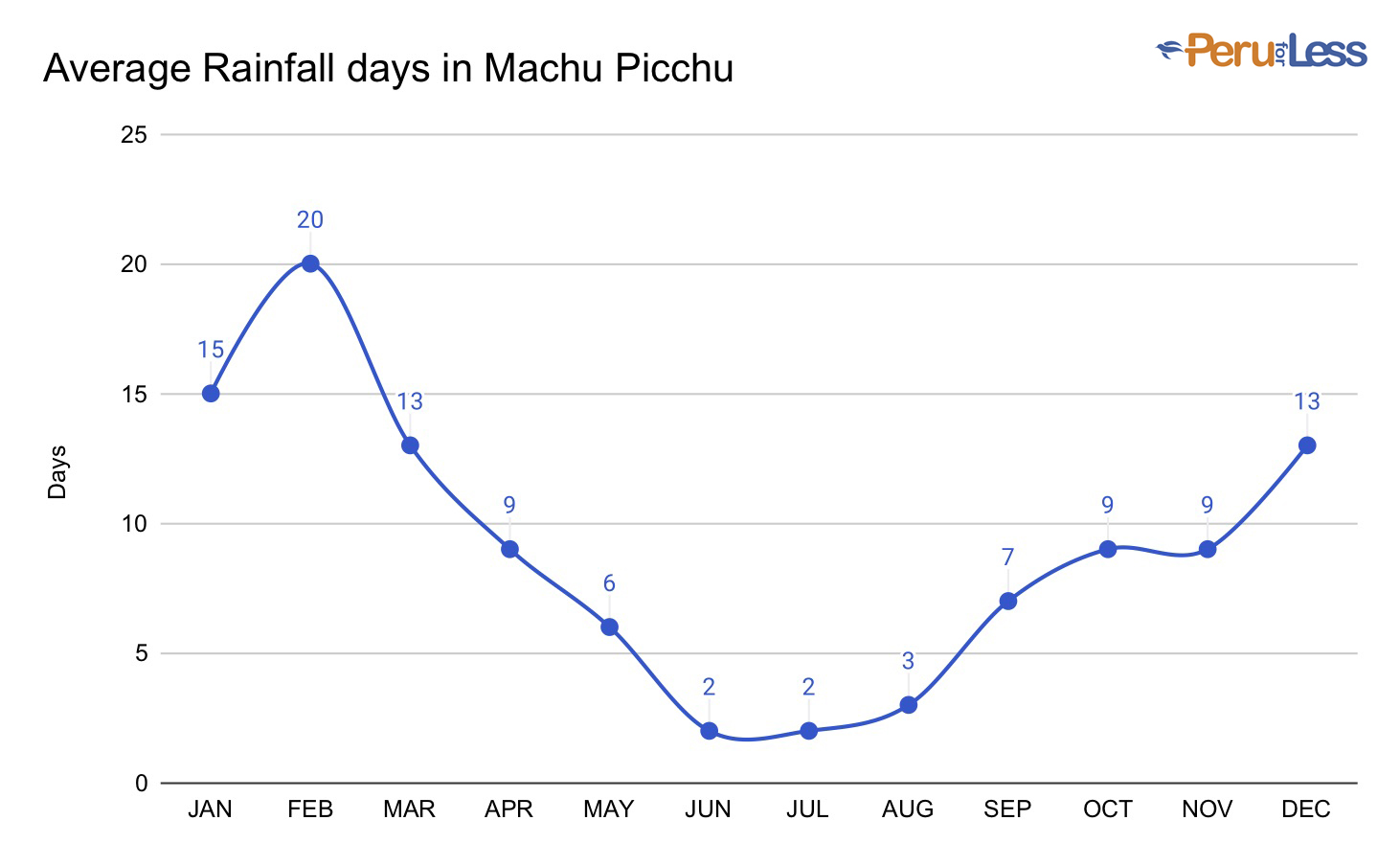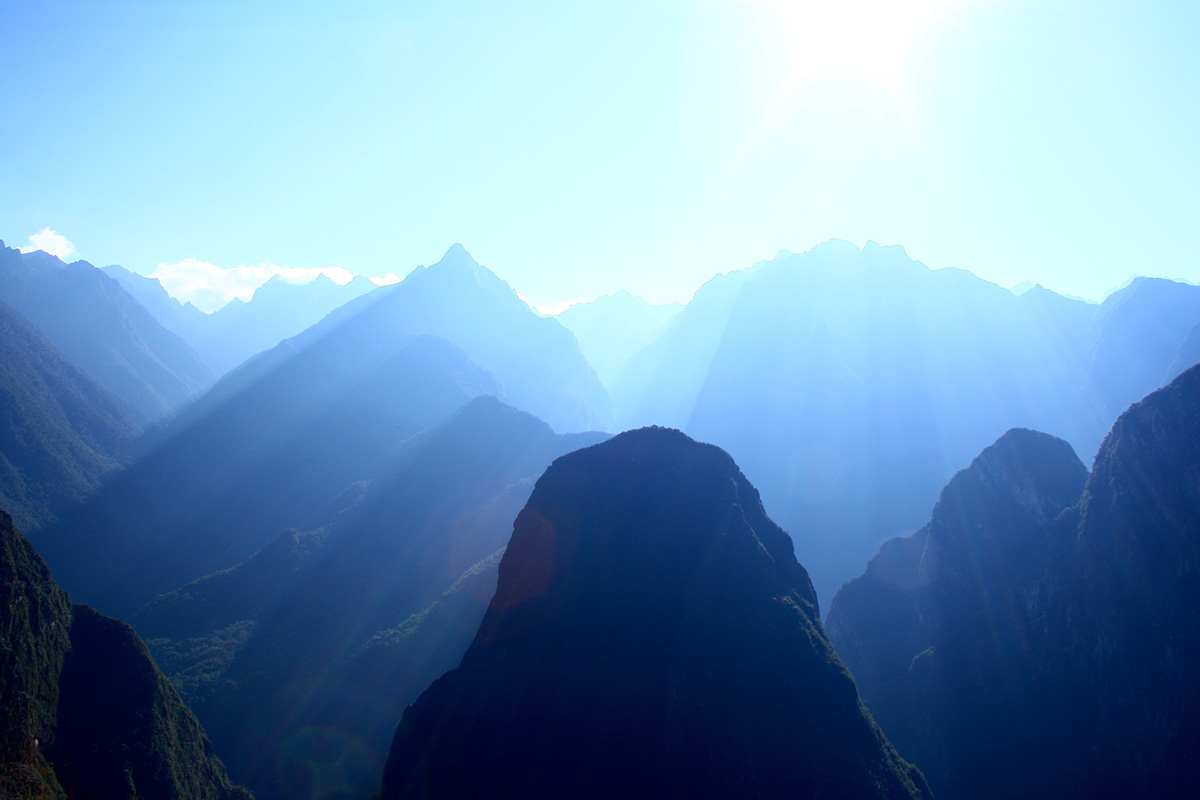
Curious about Machu Picchu weather while planning your trip to the famous Inca citadel? Consult this useful guide before booking your Machu Picchu Tour to find out what the weather will be like during your trip.
Tucked away in Peru’s cloud-forest is an incredible feat of ancient architecture. Machu Picchu is located in the Andes Mountain range, high above the Sacred Valley . Sunny winters and rainy summers make up the general climate of these subtropical highlands.
Two other important factors are the site’s proximity to the equator, as well as its elevation of over 7,972 feet or 2,430 meters. The average highs throughout the year remain fairly consistent. However, potentially frosty nights are not uncommon as temperatures begin to decline in May.
With over 100 rainy days per year, the site tops out around 71 inches or 1803.4 mm of precipitation per year. The majority can be expected beginning in the shoulder months of October and November, all the way to March. Occasional thunderstorms pass over the mountainside and, although very rare, hail is not unheard of.
On the bright side, 2,460 hours of annual sunshine also greet you while visiting Machu Picchu. Dewey mornings tend to be thick with mist. As afternoon approaches the sun finds its way through, illuminating the ruins. This becomes even likelier during the transitional month of April as the dry season approaches.
But, be prepared with lots of sunscreen and a protective hat! The ultraviolet rays are much more powerful at this altitude. Lastly, although extreme temperatures are uncommon and the terrain isn’t too challenging, it’s important to dress in layers while sporting a reliable pair of walking shoes.
Machu Picchu Tours:
When planning your ideal vacation it’s important to know the climate in Peru. The best time for your Machu Picchu vacation entirely depends on your travel preferences. In truth, every season has its advantages. It’s all about what kind of experience you’ve been dreaming of!
Peruvian seasons vary as vastly as the landscapes in this diverse country. The temperature in Lima is no indication of that in the Amazon Jungle or the Andes Mountains. In fact, even weather in Cusco and the Sacred Valley isn’t a gauge of what to expec t. So, what is the best time for Machu Picchu?
Bel ow is our official month by month guide to the weather in Machu Picchu !

Average monthly temperatures in Fahrenheit & Celsius. Photo by Peru For Less.
Machu Picchu’s rainy season occurs in the southern hemisphere’s summer, between the months of December and March. The higher chance of precipitation, beginning in January, coincides with the slower tourism season. Cloudy days can be deceiving, as the sun’s rays are still strong on your journey from Cusco to Machu Picchu.
December marks the beginning of summer here in Machu Picchu, Peru . Although it has the warmest temperatures, it is also peak time for heavy rainfall. Thunderstorms are possible during the day, as the sky is prone to change at a moment’s notice. You may ask yourself, is Machu Picchu safe to visit with all this rain? Don’t worry, the answer is yes! Trails can become more slippery, but the Peruvian government takes extreme precautions to keep all of its visitors safe. The worst you should expect is to get a little wet during your tour of the ruins.
December Monthly Averages: Night Time vs. Daytime Temperatures: Between 55.4°F and 78.8°F (13°C and 26°C) Rainfall: 4.8 inches (121mm) Humidity: 60% Daily sunshine: 6 hours UV Index: 12
January is marked by overcast skies in the early hours of the morning, eventually leading to warmer temperatures later in the day. This can help while snapping your perfect picture of the ruins . January’s milder climate is intermixed with heavy rainfall and misty horizons. Taking advantage of daylight is crucial as it can sporadically be overtaken by clouds in the afternoon.
January monthly averages: Night Time vs. Daytime Temperatures: 55°F and 77°F (12.8°C and 23.9°C) Rainfall: 5.4 inches (138mm) Humidity: 62% Daily sunshine: 5 hours UV Index: 12

Two llamas enjoying the fog. Photo by Colby Thomas on Unsplash.
Persistent rain continues in Machu Picchu as February averages about 20 days of precipitation. It may not be the best time to hike Machu Picchu, as wet trails and cloud coverage is to be expected. But, it is important to remember that when they do dissipate the sun will be strong. Wearing the proper clothing is important to protect yourself from its intensity. The cloud-forest will have you enjoying warm afternoons and humid nights.
February Monthly Averages: Night Time vs. Daytime Temperatures: 55°F and 77°F (12.8°C and 24.9°C) Rainfall: 5.6 inches (141 mm) Humidity: 65% Daily sunshine: 5 hours UV Index: 12
*Important Reminder* – Although Machu Picchu remains open, the Inca Trail is closed for the month of February. This is partly due to yearly routine maintenance, but also because the persistent rain can make the trail unsafe for travelers. It may not be the most popular time for your hike to Machu Picchu, but you’re in luck! As long as conditions remain safe, there are a few Inca Trail alternatives that you can try as well.
On average, March is the rainiest month out of the year in terms of overall precipitation. Temperatures begin their slow decline during this period, while the humidity maintains a higher heat index. Anticipate cloudy skies coming and going during the day. However, once the sky clears, there is ample sunshine to light up the Machu Picchu ruins . As with every month in the rainy season, March is beneficial if you’re looking to avoid the massive crowds later in the year. So you may get a little wet, but you’ll have much more free space while roaming the site.
March Monthly Averages: Night Time vs. Daytime Temperatures: 55°F and 77°F (13°C and 25°C) Rainfall: 5.9 inches (151mm) Humidity: 62% Daily sunshine: 6 hours UV Index: 12

Average rainfall by month at Machu Picchu. Photo by Peru For Less.
As rainfall begins to let up, and Machu Picchu weather transitions, the saturated mountainside welcomes lush vegetation and sunnier afternoons.
Being that April is a transitional period, there will be a noticeable decrease in the amount of rainfall at the Inca citadel. On average about 9 days out of the month will see rain sprinkled throughout the afternoon and into the night. As the cloud coverage reduces you may want to take a shot at climbing Machu Picchu mountain . Although, you will note an increase in other travelers making the same trek.
April Monthly Averages: Night Time vs. Daytime Temperatures: 54°F and 77°F (12°C and 25°C) Rainfall: 2.4 inches (62 mm) Humidity: 61% Daily sunshine: 7 hours UV Index: 12

Machu Picchu hiker enjoying the views. Photo by Erik Ringsmuth on Unsplash.
The dry season in Machu Picchu is also peak tourism season. Visitors flock to the blooming mountain as the chance of rainfall remains minimal over the next few months.
May, the entryway into the dry season here in the Peruvian Andes. Days become warmer and brighter, while sundown brings with it cooler mountain temperatures. There are many benefits of the recently passed rainy season. One of the best is the contrast between emerald terraces against the colossal gray stones of the ruins. Also, many days offer the ideal conditions for your incredible Huayna Picchu hike .
May Monthly Averages: Night Time vs. Daytime Temperatures: 52°F and 77°F (11°C and 25°C) Rainfall: 0.9 inches (23 mm) Humidity: 57% Daily sunshine: 8 hours UV Index: 11
June is the driest on average for your trip to Machu Picchu, with only about 2 days out of the month seeing precipitation. Rainfall is at a yearly minimum, so the chance of enjoying a clear day at the site become almost guaranteed. Expect warmer afternoons and cooler nights. Although tourism begins to pick up in May, June is the time that sees peak visitors per day. So, although the weather is more pleasant, you’ll be sharing the experience with others.
June Monthly Averages: Night Time vs. Daytime Temperatures: 48°F and 77°F (11°C and 25°C) Rainfall: 0.7 inches (17mm) Humidity: 48% Daily sunshine: 8 hours UV Index: 10
The coldest month out of the year, it’s typical to have daytime sunlight which is perfect for sightseeing. But, expect nights that cool off quickly and are frequently frosty. Machu Picchu weather can be unpredictable so although not common, hailstorms have been known to occur this time of year as well. In addition, don’t be deceived by the increase in sunshine. It is still advisable to wear layers of clothing as well as protective headwear for the temperature fluctuations.
July Monthly Averages: Night Time vs. Daytime Temperatures: 48°F and 77°F (9°C and 25°C) 48°F and 77°F (9°C and 25°C) Rainfall: 0.9 inches (22mm) Humidity: 45% Daily sunshine: 8 hours UV Index: 10

Machu Picchu mist. Photo by Alan Hurt Jr. on Unsplash.
August also falls within the winter season in the southern hemisphere. Showers are infrequent. Warm days and pleasant sunshine are the norm. The effects of low humidity increase the likelihood of bright and clear views of the Machu Picchu ruins. It’s the perfect opportunity to snap the famous shot of Huayna Picchu Mountain towering over the ancient stonework. This is considered one of the better times to visit Machu Picchu in terms of weather.
August Monthly Averages: Night Time vs. Daytime Temperatures: 50°F and 77°F (10°C and 25°C) Rainfall: 0.9 inches (24mm) Humidity: 43% Daily sunshine: 8 hours UV Index: 12
Known for having the mildest weather out of the year, September continues the theme of sunny, partly-cloudy days transitioning into chilly nights. The humidity within the cloud-forest also begins creeping back upwards, bringing with it a rise in rainfall. Along with this, the thick mist spends more time wrapped around Machu Picchu Mountain.
September Monthly Averages: Night Time vs. Daytime Temperatures: 52°F and 79°F (11°C and 26°C) Rainfall: 1.7 inches (44mm) Humidity: 51% Daily sunshine: 7 hours UV Index: 12
After several months of decreased precipitation and drier weather, Machu Picchu won’t appear as lush as it did in April. However, as with any other time of the year, this shoulder season carries its own advantages.

Average days per month of rainfall in Machu Picchu. Photo by Peru For Less.
The call of the coming rainy season becomes most prominent in October as the average rainfall almost doubles from September. Skies remain spotted with clouds as the daily humidity rises. However, enough sun makes its way through to warm up the afternoons. Not only is this a shoulder month in terms of weather, but also in terms of the declining rate of tourists.
October Monthly Average: Night Time vs. Daytime Temperatures: 54°F and 77°F (12°C and 25°C) Rainfall: 3 inches (75mm) Humidity: 51% Daily sunshine: 7 hours UV Index: 12
With the rainy season sneaking in, November doesn’t shy away from occasional afternoon showers and cloudy midday skies. Machu Picchu temperature s gradually increase as does a jump in precipitation. As the average visitor count slows, many businesses are hoping for one last push before the low tourist season. For those who want to travel on a budget, you might get lucky and find a few good deals.
November Monthly Average: Night Time vs. Daytime Temperatures: 55°F and 79°F (13°C and 26°C) Rainfall: 3.4 inches (86mm) Humidity: 53% Daily sunshine: 7 hours UV Index: 12

Rays of sunlight covering Andean peaks. Photo by Nad Hemnani on Unsplash.
For more info make sure to visit our full guide to the best time to visit Machu Picchu .



Email: [email protected]
Sign up to receive our newsletter for great articles, stunning photos, and special deals.